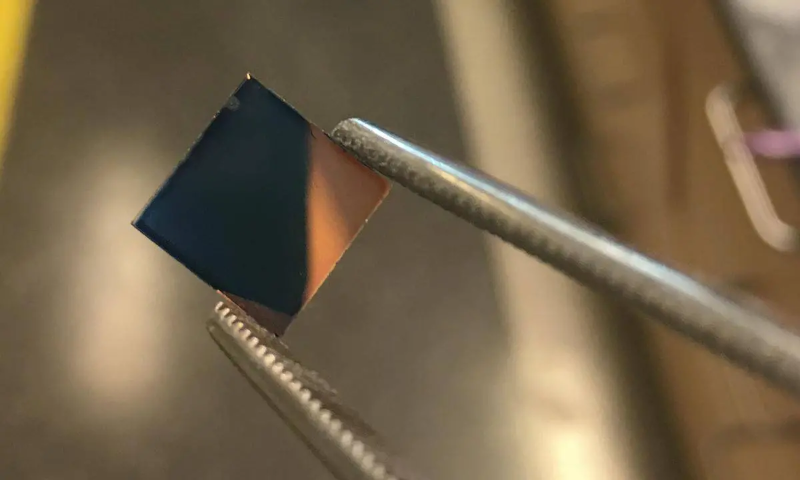There’s an old series of jokes that starts with: “How do you put an elephant in a refrigerator?” The answer is to open the door, put the elephant inside, and close the door. Most people don’t get that because it is too simple, and simple is the approach Georgia Tech researchers have taken when faced with the problem of using a particular conductive plastic. PEDOT, the plastic in question, is a good conductor, but it is hard to work with. You can add materials to make it easier to work with, but that screws up the conductivity. Their answer is much like the refrigerator joke: add material to PEDOT, paint or print it where you want, and then remove the extra material. Simple.
The polymer needs side chains to be soluble. This allows you to mix an ink or paint made of the material, but the waxy side chains interfere with the material’s conductivity. However, after application, it is possible to break off the side chains and flush them out with a common solvent. The process is simple, and leaves a flexible conductive material that’s stable.
The work has applications anywhere you need a flexible conductive material. As a side benefit, after processing, the material is also optically clear. You can imagine that wearable technology could easily take advantage of this. While it doesn’t seem like normal 3D printing techniques would be useful with this, it isn’t hard to imagine an inkjet-like printer along with some sort of post-processing setup is within reach of the average garage lab.
While the results are interesting, be sure to temper your expectations. The material has a reported conductivity of 1,000 siemens per centimeter. Copper, admittedly a good conductor, clocks in at 590,000 S/cm. Graphite, for example, is about as conductive as the new material.
Good conductive ink would change PCB production, at least for small prototype runs. You can make pretty good conductive ink on your own, of course.
















A very apt metaphor.
Though I’m not quite sure how useful it’ll be until they get the conductivity a bit higher.
There are people who have built entire business empires on the basic premise of the elephant and the refrigerator. They just had to build a bigger fridge, or find a smaller elephant.
you are perhaps thinking in terms of power. Nearly no power needed if the ink path is for a signal input to CMOS or between CMOS chips
“Graphite, for example, is about as conductive as the new material” .. You can make “workable” circuits simply drawing on any surface that will allow you to build up a reasonably thick pencil line. Of course, the lines don’t carry much power, long traces don’t necessarily work well, and switching speeds are bad .. But it’s definitely one of those hacks that “doesn’t not work”
Mylar drafting film works well .. Any PET with a matte surface works pretty well.
And the applications aren’t limited to conventional circuits .. We managed to get C elegans nematodes to walk along a pencil line by running current through it. Nematodes tend to follow electric gradients, so we presumed that they were “drawn” by the voltage gradient in the pencil lines. In this case, we used disposable weigh-boats, which I think are usually frosted polystyrene.
In any case, unless this stuff can be tweaked to handily out perform a pencil trace by several orders of magnitude, it seems like jist a mildly interesting curiosity.
If it’s only slightly conductive then why not use the conductivity it does has to electroplate it with something very conductive?
Because it’s meant for use where you need flexibility and transparency. Bit hard to be transparent when you electroplate it with metal…
Conductive plastics are also used in electrolytic cells and fuel cells, because they don’t dissolve in the electrolyte.
The normal units for specifying the resistance of a sheet material (e.g. copper on a PCB) is “ohms per square”. https://www.edn.com/ohms-per-square/
1 mOhm/cm is not a useful characterisation, since the value depends on the geometry and other dimensions.
This is a volumetric conductance, not surface.
Clear and conductive you say? Could this be a potential replacement for Indium Tin Oxide?
I’m gonna have to go read further into this.
We use flexible PEDOT sensors at work. They are very close to transparent and allow light to pass though them with little interference. The optical quality, at least on the ones we use, would not be sufficient to replace ITO on an LCD touch screen though.
I guess we should have just put a guy in a rocket, closed the door and opened it on the moon. Much simpler than all the contortions NASA went through in the 60’s
Huh. Learned something. I put “I don’t get the joke” in brackets and it omitted them from my comment.
I don’t get the joke.
Sub 10 um lines can be plated with copper and chemically blackened to reduce reflection. To the human eye, invisible if the mesh is wide and improved further by changing the direction from completely straight to slightly wavey between points.
Sounds like the perfect means to make precision tuned resistors. Then again, if they get the conductivity up enough, fiber optics would be able to either increase data capacity (just shy of half copper conductivity) or allow for more intelligent data routing/switching (2x graphite conductivity). I would love to see how it works out.